
94% of researchers rate our articles as excellent or good
Learn more about the work of our research integrity team to safeguard the quality of each article we publish.
Find out more
ORIGINAL RESEARCH article
Front. Urol., 26 October 2022
Sec. Urologic Oncology
Volume 2 - 2022 | https://doi.org/10.3389/fruro.2022.955882
This article is part of the Research TopicGenitourinary (GU) Oncology in Low-to-Middle Income CountriesView all 5 articles
 Sarah Ibrahim1
Sarah Ibrahim1 Theresa Farhat1
Theresa Farhat1 Rim Baalbaki1
Rim Baalbaki1 Michael Aoun2
Michael Aoun2 Georgio Toumieh3
Georgio Toumieh3 Malak Kaddoura1
Malak Kaddoura1 Lubna Jaber1
Lubna Jaber1 Ali T. Taher4
Ali T. Taher4 Zahi Abdul-Sater1*
Zahi Abdul-Sater1*Background: The genitourinary cancer burden in the Arab region is rising at an increasing pace. The main objective of this study was to conduct a bibliometric analysis of scientific publications on genitourinary cancer to understand the growth, impact, trends, and flow of knowledge within GU cancer research in 22 Arab countries.
Methods: The Web of Science databases were searched for publications related to genitourinary cancer research in the 22 Arab countries from January 1, 2002, till December 31, 2021. The scientific research was evaluated based on productivity (number of published documents, authorships), impact (citation counts and journals impact factor), collaborations, and areas of interest for published papers.
Results: A total of 3,129 papers met the inclusion criteria in this research. After adjusting for the population power, Qatar (53.57) and Lebanon (46.83), Saudi Arabia (46.21), Jordan (41.58), and Tunisia (40.72) had the highest research productivity. The number of articles and average citations per year was generally increasing. Most Arab corresponding authors were from Egypt, Saudi Arabia, and Tunisia, and most Arab first authors were male researchers, highlighting gender inequality in genitourinary cancer research. Both regional and international collaborations are weak between authors in the field.
Conclusion: This bibliometric research provided a framework for visual and quantitative research productivity on GU can in the Arab world. Research output is low in some countries, which can be improved by investing in more international and national collaborative research projects in the field of GU cancer.
The Arab world comprises 22 countries, most of which are low-middle income countries (LMICs) (1). Mirroring the global trend, the Arab world shoulders a growing burden of non-communicable diseases (NCDs), accounting for nearly 57% of all deaths in the region (2). Leading NCDs include cancer, diabetes, cardiovascular diseases (CVDs), and chronic respiratory diseases. Still, the Arab world did not generate the research needed to contextually understand and address the heavy burden of NCDs. Indeed, health research productivity in these countries is hindered, evidenced by the low number of original research publications and citation frequency (3–5). This research landscape is marred by a lack of proper investment, contextualized tools, human resources, and specialized research centers, in addition to endemic and recurrent conflicts in the region. For instance, except for United Arab Emirates (UAE), none of the Arab countries spend more than 1% of their gross domestic product (GDP) on research and development, compared to the global average of more than 2% (5, 6).
In recent years, while health research productivity has improved in the Arab world, cancer research remains undermined and inadequate (7). This is alarming, given that the cancer burden is increasing worldwide, particularly in the Arab region, despite the advancement in treatment and diagnosis (8). The contribution of Arab countries and institutions to cancer research is quite limited (9, 10). For example, a geographically and temporally limited study highlighted that cancer research productivity in Arab countries is lower than in the United States (US), Europe, and Japan, mainly due to the limited number of researchers, and lack of funding, networking, and research support (11). A recent study examining the status of prostate cancer research in the Arab world identified a positive correlation between the GDP and research output, a focus on diagnosis and treatment rather than screening and prevention, and a lack of research funded or co-authored by women (12). To holistically understand the evolution of research productivity on cancer in the Arab world, such studies should be expanded to other types and categories within the field of oncology, including genitourinary (GU) cancers.
GU oncology is a specialized field that focuses on cancers found in the urinary system of men and women, and the reproductive system in men (13). The major sites included are the kidneys, bladder, urethra, ureters, prostate gland, testicles, and penis. Globally, prostate and bladder cancer are ranked fourth and tenth most common cancers, contributing to 7.8% and 3.2% of the total number of newly diagnosed cases, respectively (14, 15). Although GU malignancies globally account for 23% of new cancer diagnoses and approximately 10% of cancer deaths, the field remains underrepresented in basic sciences, epidemiologic, clinical research, and translational research (16).
Importantly, in the Arab World, the incidence and mortality of GU cancers have significantly increased in recent decades, with aging population and increased socioeconomic status (17). Still, the knowledge base, research output, and collaboration landscape around GU cancers in the Arab world have not been examined. Against this backdrop, this study employs bibliometric analysis to tease out the differential research and productivity, impact, and collaboration of GU cancer research in Arab countries.
A bibliometric study was conducted to evaluate the scientific publications focusing on GU cancer research in the Arab countries and the bibliographic for each country. Bibliometrics is a statistical analysis and quantitative tool to evaluate the growth, impact, and trend of scientific publications. The Web of Science (WoS) was the source of the bibliographic data, as it contains the most comprehensive information about scientific research and is the most used in bibliometric analysis (18).
The selected topics in the WoS were related to GU and cancer (details in Supplemental Material 1). Key search words were chosen from previous studies, reviews, or meta-analyses on cancer research and were utilized to search for titles and abstracts. The subject areas selected for this research were oncology, urology, and nephrology. The selected journals were bladder cancer, kidney cancer, prostate cancer, urologic oncology, and clinical genitourinary cancer. Then, all 22 Arab countries were entered as country affiliation (i.e., Algeria, Bahrain, Comoros, Djibouti, Egypt, Iraq, Jordan, Kuwait, Lebanon, Libya, Mauritania, Morocco, Oman, Qatar, Palestine/Gaza, Saudi Arabia, Somalia, Sudan, Syria, Tunisia, United Arab Emirates, and Yemen) based on the United Nations (UN) Habitat definition (19, 20). Four indices were used: Science Citation Index Expanded (SCI-EXPANDED), Social Sciences Citation Index (SSCI), Arts & Humanities Citation Index (A&HCI), and Emerging Sources Citation Index (ESCI).
Articles concerned with original GU cancer research with at least one of the author’s institutions from any of the 22 Arab countries were included. The period of the index date was from January 1, 2002, to December 31, 2021, with the language restricted to English. The document types included were articles, article data, and article early access. No filter was applied to the type of study, accordingly, all types of studies (basic research, clinical research, epidemiological research, as well as secondary research) were included. All other types of articles were excluded. Other reasons for exclusion were publications not related to GU cancer or focused on the female reproductive system or reviews or meta-analyses (n=2,798, 47%).
Full metadata information on articles identified was downloaded in text format and then imported to an excel file. Two reviewers independently screened the titles and abstracts of retrieved publications. Discrepancies in decisions about whether to include or exclude a particular reference were resolved through discussion and/or full-text screening and reasons for exclusion were recorded.
The final list of references was then analyzed. The analysis was completed using the Bibliometrix Package, which is an R statistical software package for comprehensive science mapping analysis (21). The raw data exported from R was transformed into graphics and tabular format using the Flourish software (22) to generate the following information: (a) Annual scientific production and article citation; (b) journals in which GU researchers publish; (c) country-specific production; (d) author’s countries; (e) collaboration patterns; (f) gender distribution of authors by countries; and (g) author’s keywords and title co-occurrence. The gender of the authors was determined using the gender API (gender-api.com) which uses the first name of the author and the suspected country of origin as inputs. Authors with no scores or scores <90 and first names shorter than 2 letters were filtered out.
This study is exempt from the American University of Beirut Institutional Review Board (IRB) since the researchers used publicly available information and did not involve any interactions with human participants.
Data from WoS were exported to Excel and then to the PRISM program version 9 for analysis, where relevant. Categorical data are expressed as numbers with percentages. The journal’s impact factor (IF) and quartile (Q) were evaluated using the Journal Citation Report (JCR; Web of Knowledge). Publication activity was adjusted for the 22 countries categorized by population size retrieved from the online databases of the World Bank (23). We performed linear regression analysis to assess the statistical significance of the increasing trend in annual publications between 2002 and 2021. The model included the numbers of publications each year (as the dependent variable) and the year (as the independent variable). P<0.05 was considered to indicate statistical significance.
The search strategy identified 5,927 publications from the 22 Arab countries in the WoS. After applying the inclusion criteria detailed in the methodology section, the final number of publications was 3,129, with an average of 156.4 documents per year. Reasons for exclusion were publications not related to GU cancer or focused on the female reproductive system or reviews or meta-analyses (n=2,798, 47%). Figure 1 shows the annual number of documents published in the past decade. The results indicate a significant increase from 28 articles in 2002 to 563 in 2021 according to the linear regression results (P< 0.0001) (Figure 1). Nonetheless, despite the upward trend, the Arab world research output on GU cancer over the 20 years is still dramatically lower than that of the US and Europe (Figure S1). The average citation per year was generally increasing, however, the increase in yearly articles was associated with a sharp drop in the average citation after 2015 and a more pronounced decrease (67.5%) between 2019-2021 (Figure 1) (24).
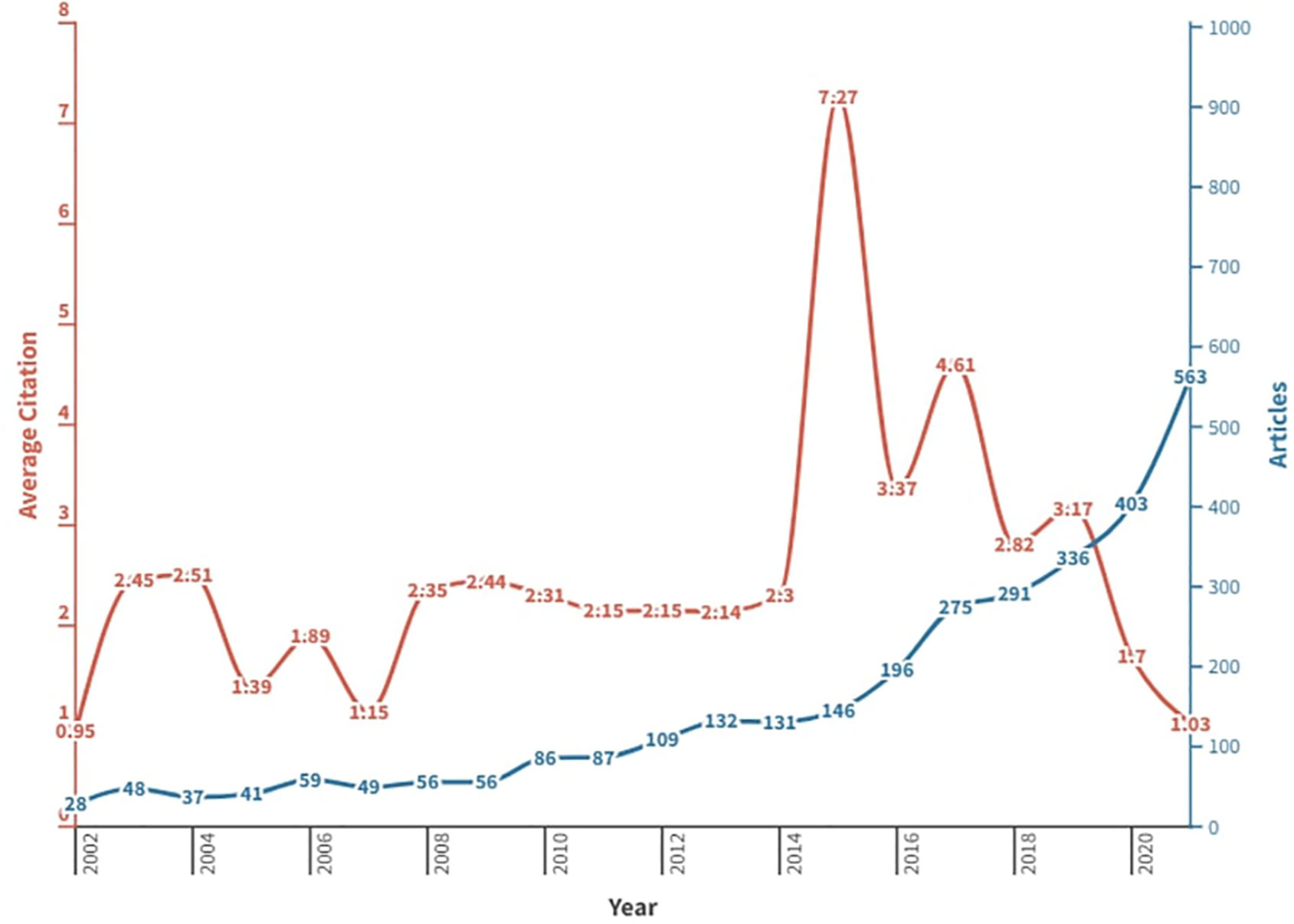
Figure 1 Annual scientific production and article citation per year on genitourinary cancer research in the Arab world from 2002 to 2021.
The retrieved documents were published in 996 sources including journals, books, and others. On average, these documents were cited around 16 times, with 5.07 authors per document and a collaboration index of 5.24 (Table 1). Around 67 articles (2.1%) were published in Urologic Oncology-Seminars and Original Investigations (Impact Factor [IF] of 2.954 and Q3 at the time of data analysis) whereas 59 documents (1.9%) were published in the Urology Case Reports journal (IF of 2.649 and Q4) and the Journal of Urology (IF of 7.6 and Q1). This was followed by 55 documents (1.7%) published in the BJU International (IF of 2.649 and Q1), and 51 (1.6%) published in the Clinical Genitourinary cancer journal (IF of 3.121 and Q3) (Figure 2; Figure S1).
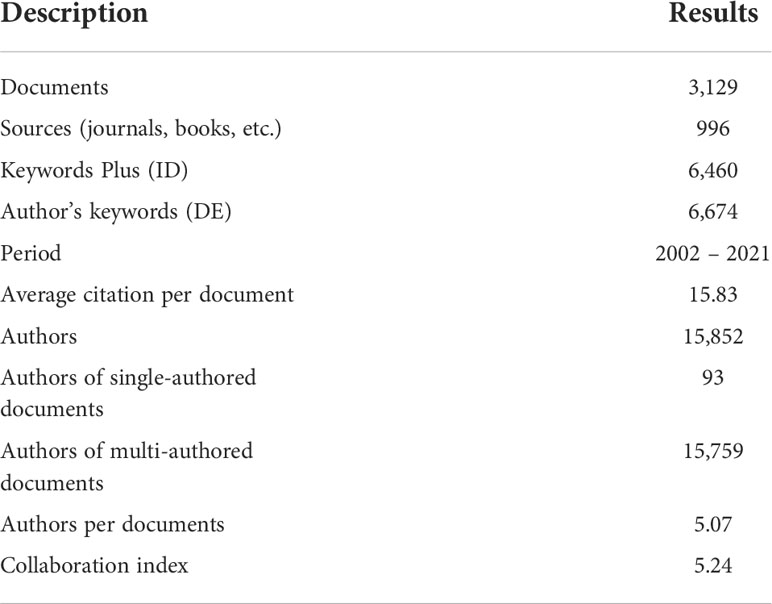
Table 1 Summary of the main information of collected bibliometric data in the Arab world from 2002 to 2021.
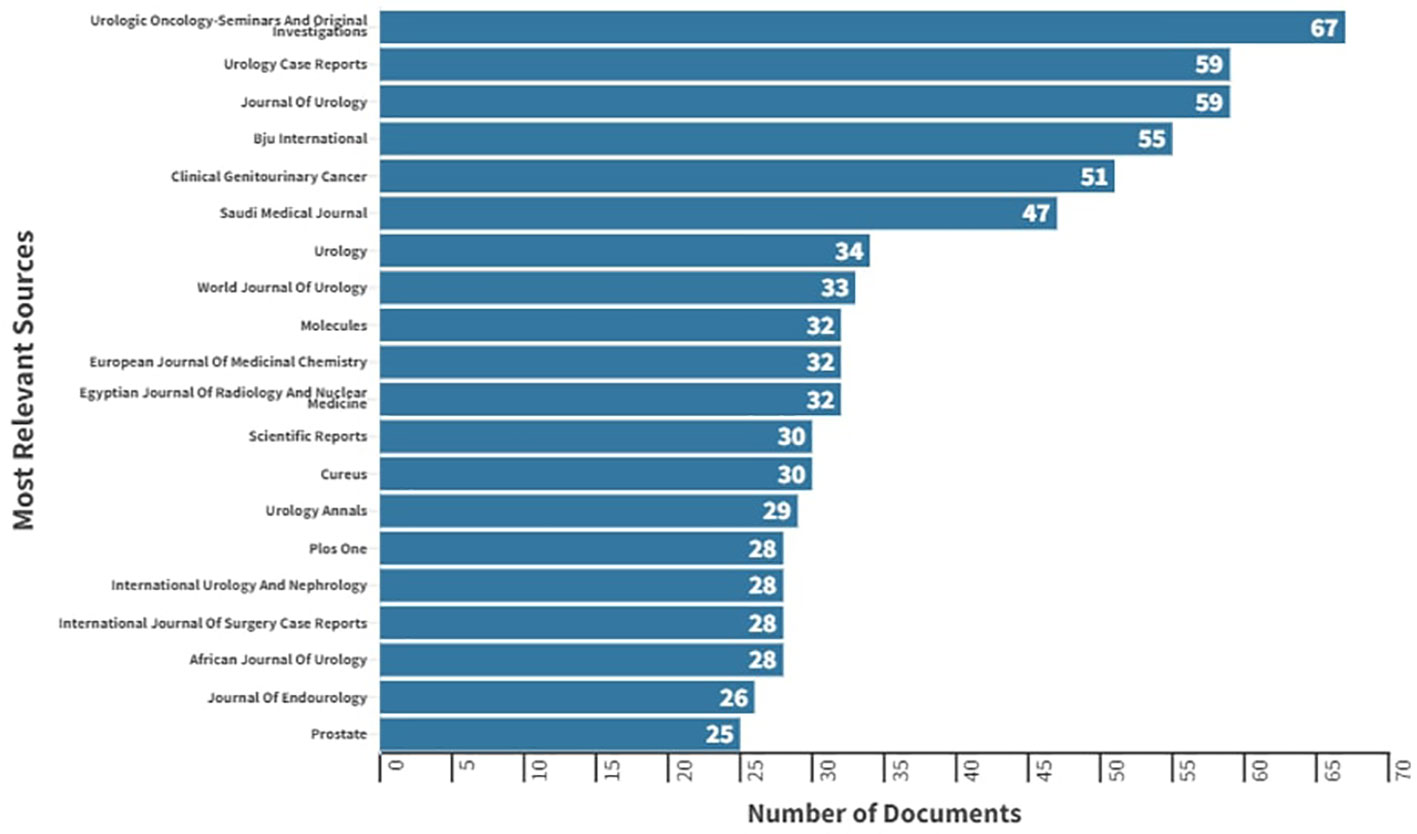
Figure 2 Top 20 most relevant sources by the number of documents published on genitourinary cancer research in the Arab world from 2002 to 2021.
When the data were analyzed by country, the highest number of authors were from Egypt (2,730, 87.2%), followed by Saudi Arabia (1,633, 52.2%), Tunisia (486, 15.5%), Jordan (427, 13.6%), and Lebanon (317, 10.1%) (Figure 3A). After adjusting for population power, Qatar (53.57) and Lebanon (46.83) had the highest research productivity, followed by Saudi Arabia (46.21), Jordan (41.58), and Tunisia (40.72) (Figure 3B).
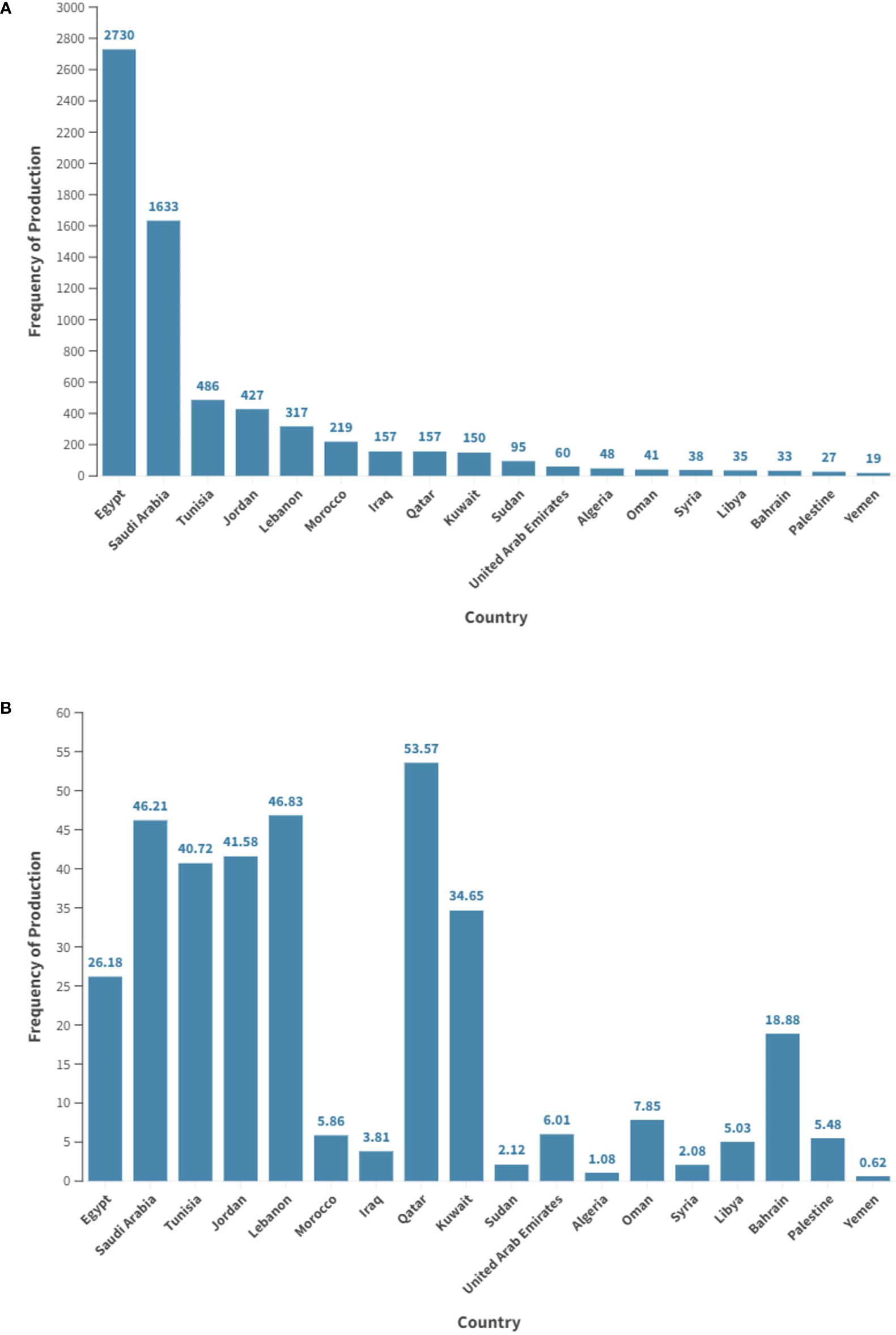
Figure 3 Absolute (A) and adjusted (B) country-specific production on genitourinary cancer research in the Arab world from 2002 to 2021.
From 2002 to 2021, there were 15,852 authors for the 3,129 published documents, with 93 authors on single-authored documents and 15,759 authors on multi-authored documents (Table 1). Of the authors analyzed, 9,227 (58.3%) were affiliated with non-Arab institutions, mostly from the USA (2,456), Canada (651), the UK (588), Germany (587), and Italy (501). Additionally, around 61.6% (1,923) of the corresponding authors were from Arab countries while the remaining 38.4% (1,199) are from non-Arab countries, mainly USA (335), Canada (125), Germany (90), UK (82), and Austria (69). Most Arab corresponding authors were from Egypt, Saudi Arabia, and Tunisia, with 75.8%, 57.2%, and 78.7% of their publications being single country publications (SCP), respectively (Figure 4). Moreover, Morocco, Jordan, Lebanon, Kuwait, Iraq, Bahrain, and Sudan had more than 50% of their corresponding author’s publications as SCP. To investigate the collaborative landscape, we analyzed the authors’ countries’ linkages in the dataset. Three main collaboration clusters were identified (Figure 5). The first cluster included Egypt, Saudi Arabia, Syria, Oman, and Kuwait, with major linkages with USA and India. The second cluster included Jordan with main collaborations with European countries, Japan, Iran, and Canada. Finally, the third cluster included Lebanon, Iraq, Qatar, Morocco, Libya, Bahrain, UAE, Tunisia, and Algeria, with non-specific linkages. These clusters further highlight the siloed research around GU cancer in the Arab World.
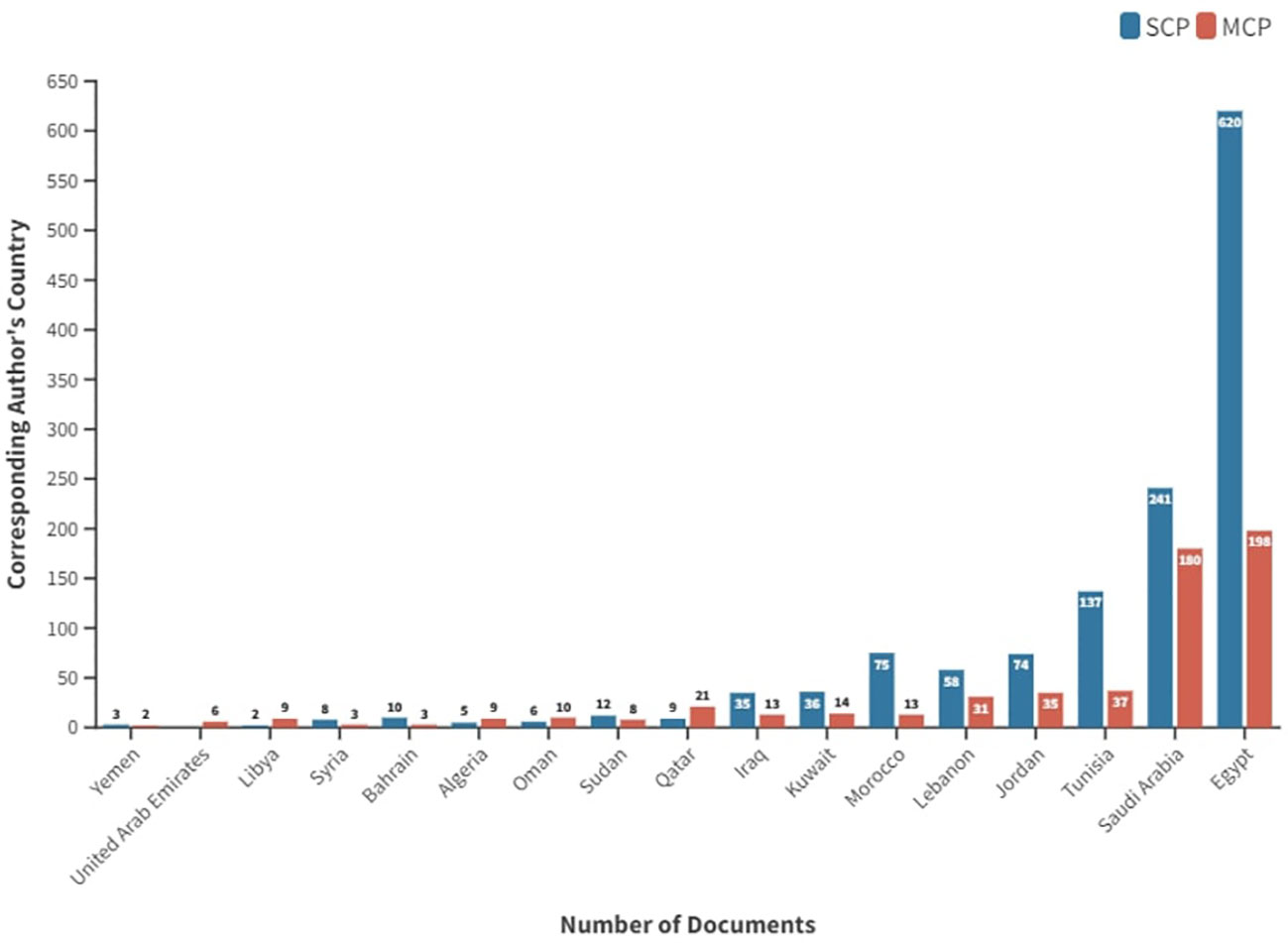
Figure 4 Top 20 corresponding authors’ countries on genitourinary cancer research in the Arab world from 2002 to 2021. The dark blue bars demonstrate the publication rate by authors from the same country (Single Country Publication; SCP). The red bars represent the number of publications by the corresponding author’s country, with at least one foreign co-author existing (Multiple Countries publication; MCP).
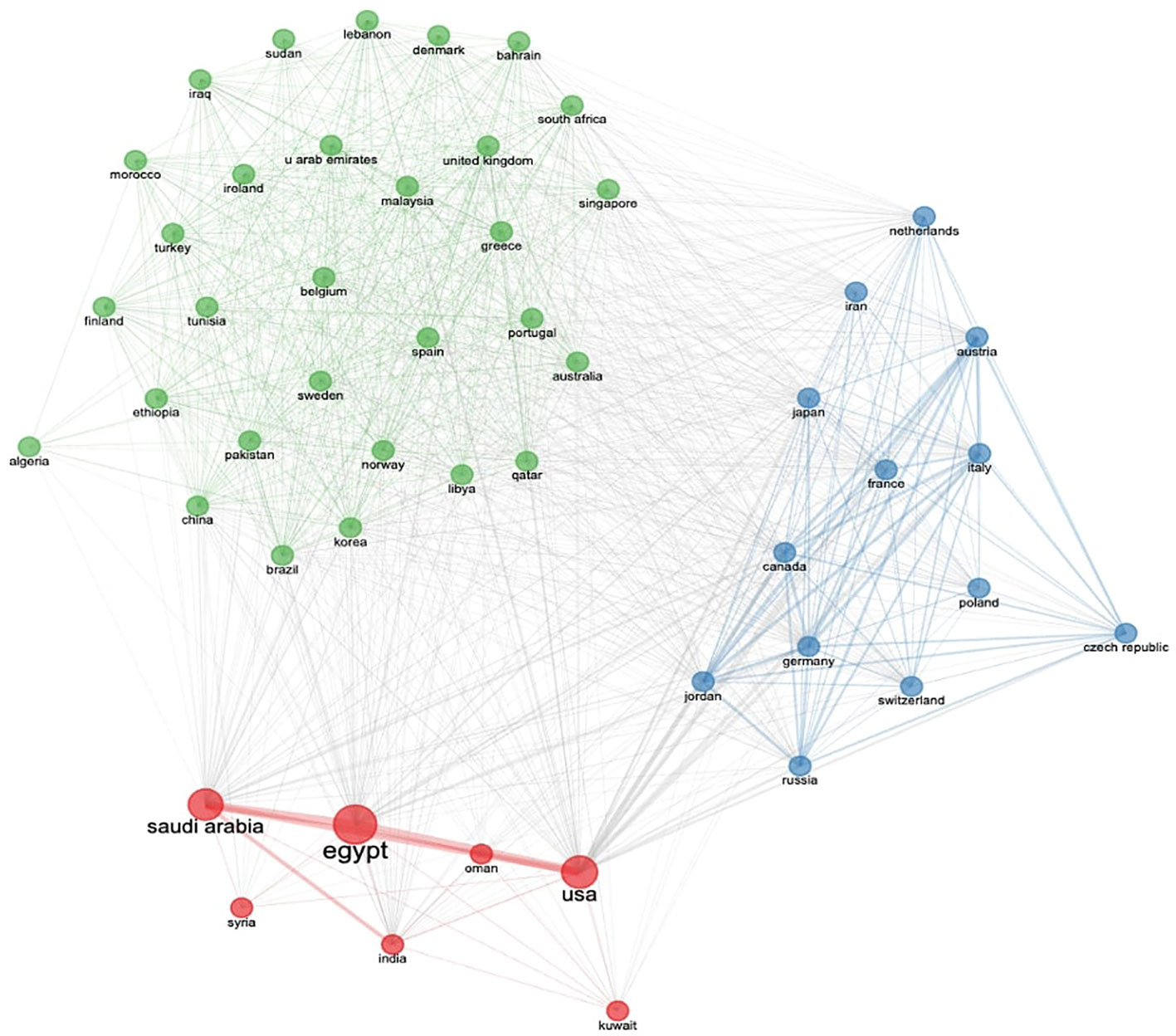
Figure 5 Country collaboration on genitourinary cancer research in the Arab world from 2002 to 2021. The font size and circle diameter indicate the number of publications in the country within the dataset. The lines’ thickness demonstrates the strength of the collaboration between the countries.
To investigate the distribution of retrieved documents authors by gender, we used the Gender API tool for the 1,440 first authors that were included based on the criteria mentioned in the methodology section. The majority of the first authors were males (71.1% [1,024]) and 28.9% (416) were females (Figure 6A). All Arab countries, except Bahrain, are dominated by male researchers. The only countries in which the female-to-male gender ratio is close to 1 are Bahrain, UAE, and Tunisia. The average male-to-female ratio for Saudi Arabia, Jordan, Qatar, Oman, Sudan, Palestine, and Libya exceeds 3. Notably, no first female authors were identified in Syria and Yemen (Figure 6B).
To understand the knowledge base on GU cancers in the Arab World, the author’s keywords and title co-occurrence were analyzed. The bibliometric data on the Arab countries’ GU cancer research detected 6,674 author keywords (Table 1). The terms and their occurrences are depicted in a word cloud (Figure 7). The keywords “bladder cancer”, “cancer”, “renal cell carcinoma” and “prostate” were top-ranked, reflecting the focus of the GU cancer research in the Arab world. The co-occurrence of titles used in GU cancer research reveals four major themes (Figure 8). Three themes, and their associated keywords, were site-specific: prostate, bladder, and cancer. A separate theme focused on the basic and clinical research around GU cancers and included co-occurring keywords such as cytotoxic, molecular, inhibitors, etc.
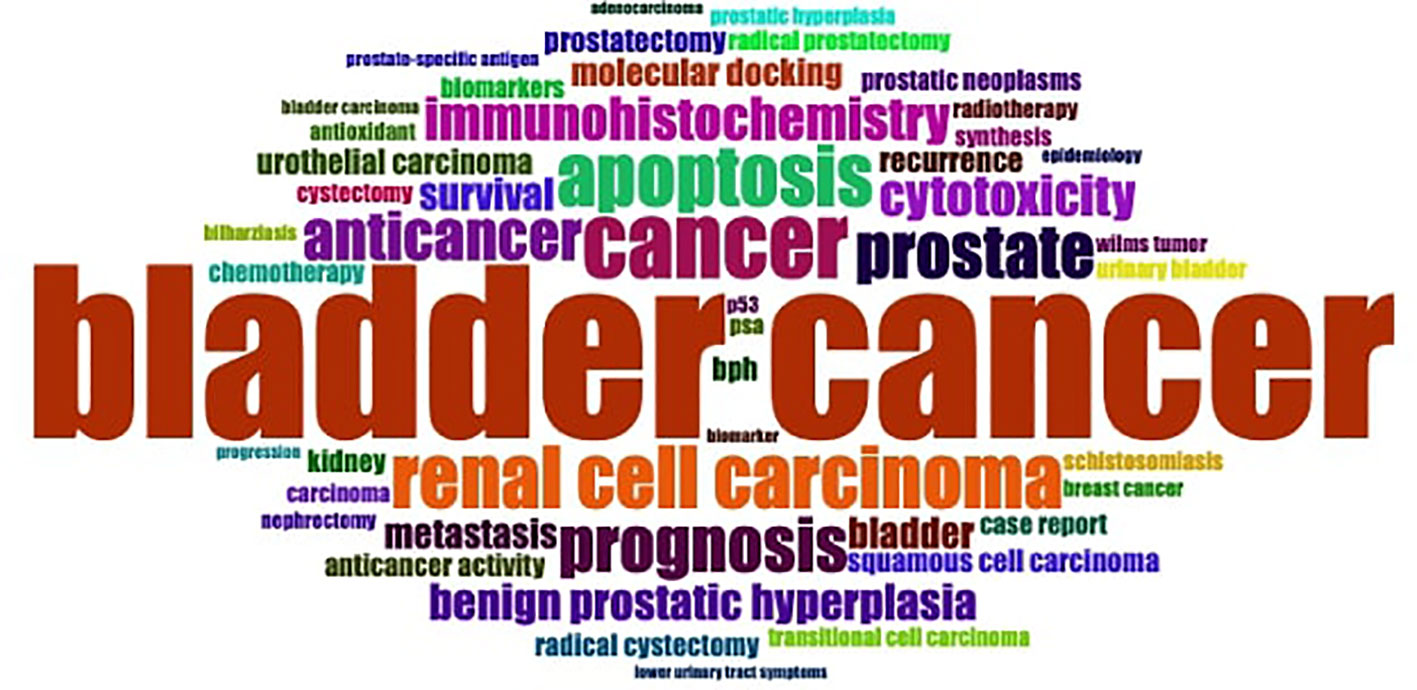
Figure 7 Word cloud for top author keywords of genitourinary cancer research in the Arab world from 2002 to 2021.
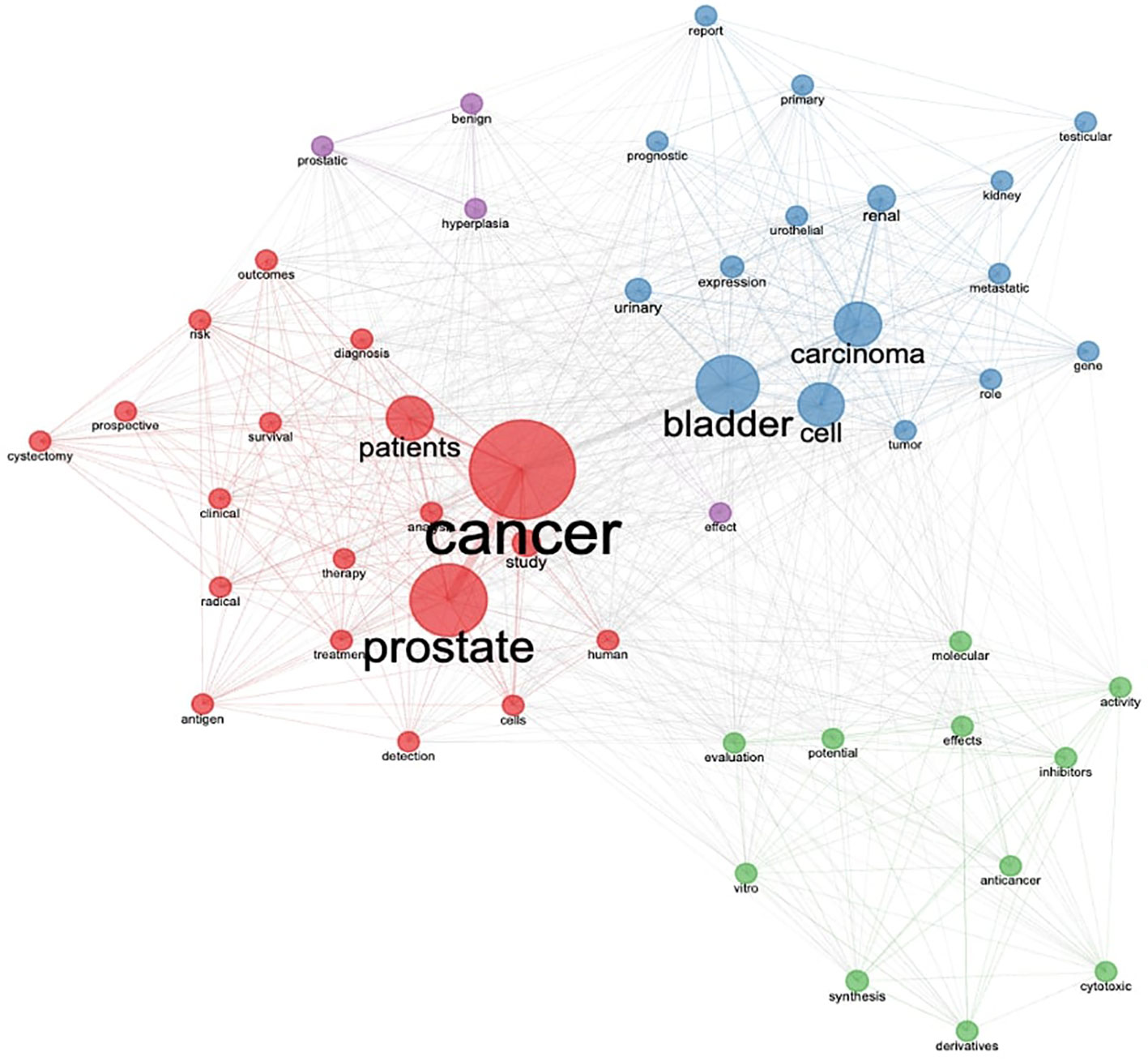
Figure 8 Co-occurrence by titles on genitourinary cancer research in the Arab world from 2002 to 2021. The circle diameter represents the occurrence of the keyword. The edge size is proportional to item co-occurrence. Co-occurring keywords are grouped under different colors.
The current study analyzes the research landscape of GU cancers in the Arab world from 2002 to 2021. GU cancers comprise several fields of cancer including prostate, bladder, renal, penile, urinary, and testicular cancers. The study uncovers a steady increase in research productivity on GU cancer, mirroring the overall trend of cancer research productivity in the region (25). The most prolific countries are Egypt and Saudi Arabia, which are in line with other studies in the region, owing to their large population and relatively strengthened research capacity (25). High-income countries such as Qatar produced the most publications when adjusted to population. This is predictable as high-income countries heavily invest in research and development, research institutions, and human resources compared to LMICs (26). On the other hand, many low-income countries such as Yemen, Sudan, Syria, and Libya, have minimal research output on the topic. These countries are plagued with recurrent conflicts, and political and economic instability, which also translates into low investment and prioritization around research and development (5). Comparably, the total number of publications on GU cancer in the Arab region is considerably lower than in the US and Europe, which mirrors the broader trend in cancer research (9).
Findings of the study reveal a weak authorship landscape of GU cancer research in the Arab region, as more than half of the retrieved authors are non-Arab. However, most of the corresponding authors (62%) were from Arab countries, which is reflective of authors who are generally responsible for the study design and leadership of research (27, 28). Furthermore, in line with other studies in the region, the current study reveals a gender difference within health research as the first authors were mostly men. This indicates that women in developing Arab countries remain underrepresented, potentially due to cultural and socio-political factors (29, 30). Indeed, one in three researchers is a woman in the Arab region (37%) (31).
The study also sheds light on the low quality of research produced on GU cancers, evidenced by the average citations and journal placement. Indeed, in addition to the low average citation rate, a decline in the annual average citation in the last 3 years was observed, despite a sharp increase in research output. The decline coincided with the start of the COVID-19 pandemic in 2019, which caused a remarkable shift to pandemic-focused publication, potentially hindering bibliometric indicators related to GU cancers (32). The COVID-19 pandemic has severely impacted healthcare systems and medical research around the world which resulted in a dramatic increase in COVID-19 publications and a significant decline (18%) in non-COVID-19 research (33). Furthermore, the majority of documents on GU cancers were published in journals with a low impact factor, which may have publication exposure and citation frequency (34). Only 3 sources out of the top 20 were Q1.
A cross-cutting theme emerged in the study depicted by the weak collaborative landscape, with minimal regional and global collaborations, and more importantly, a high rate of country single-country publications in all Arab countries. This reflects the tilted balance towards within-country publications instead of regional or global collaborations. This is particularly relevant given that global and regional collaboration is needed to facilitate knowledge exchange and is key in ensuring research quality and funding (35). Indeed, international collaboration has proven to increase the quantity and quality of research activity, as well as the visibility of scientific production in the Arab region (36). In addition to international collaborations, research collaboration among Arab countries is pivotal to facilitate the exchange of experience and knowledge in the region (37). Finally, the findings of this study also revealed that most of the author’s keywords and the titles co-occurrence do not mention terms related to early screening, diagnosis, and treatment, reflecting the need to pool more resources and build capacity for increased clinical-based studies.
This study attempted to tease out the knowledge base and research output around GU cancers in the Arab World. While research productivity is increasing, the quality, focus topics, and cross-country collaboration are still lagging. The results emphasized the research poverty in the region, adding to the calls for building research infrastructure, capacity, and collaborations. Higher education institutions in the Arab region should build new bridges of collaboration regionally and internationally to promote GU cancer research in the region. More importantly, an increase in research funds is necessary to increase the volume of data available for research among Arab countries. Lastly, a gender balanced approach to GU cancer research should be employed to ensure proper inclusion and representation of women in health-related research in the Arab world.
The raw data supporting the conclusions of this article will be made available by the authors, without undue reservation.
ZA-S and AT contributed to the conception and design of the study; SI and ZA-S in the acquisition of data; SI, TF analysis and interpretation of data; RB and MA data cleaning; SI, TF, GT, MK, LJ, AT, and ZA-S drafting the manuscript; ZA-S and AT critically revising and overseeing the work. All authors contributed to the article and approved the submitted version.
The authors declare that the research was conducted in the absence of any commercial or financial relationships that could be construed as a potential conflict of interest.
All claims expressed in this article are solely those of the authors and do not necessarily represent those of their affiliated organizations, or those of the publisher, the editors and the reviewers. Any product that may be evaluated in this article, or claim that may be made by its manufacturer, is not guaranteed or endorsed by the publisher.
The Supplementary Material for this article can be found online at: https://www.frontiersin.org/articles/10.3389/fruro.2022.955882/full#supplementary-material
Supplementary Figure 1 | The total number of publications on GU cancer in the Arab region, the US, and Europe from 2002-2021 (Based on unfiltered data).
Supplementary Table 1 | Top 20 most relevant sources by the number of documents, Impact Factor (IF), and quartile (Q) ranking published on genitourinary cancer research in the Arab world from 2002 to 2021.
1. Review WP. High income countries 2022 . Available at: https://worldpopulationreview.com
2. El-Saharty S, Kaneda T, Liu AC. Tackling noncommunicable diseases in the Arab region. In: Handbook of healthcare in the Arab world. (Springer Nature Switzerland AG) (2021). p. 789–836.
3. Benamer HT, Bakoush O. Arab Nations lagging behind other middle Eastern countries in biomedical research: A comparative study. BMC Med Res methodol (2009) 9(1):1–6. doi: 10.1186/1471-2288-9-26
4. Zyoud S, Al-Jabi SW, Sweileh WM, Awang R. A bibliometric analysis of toxicology research productivity in middle Eastern Arab countries during a 10-year period (2003–2012). Health Res Policy systems (2014) 12(1):1–13. doi: 10.1186/1478-4505-12-4
5. El Rassi R, Meho LI, Nahlawi A, Salameh JS, Bazarbachi A, Akl EA. Medical research productivity in the Arab countries: 2007-2016 bibliometric analysis. J Global Health (2018) 8(2). doi: 10.7189/jogh.08.020411
6. The World Bank. Research and development expenditure (% of GDP) - Arab world. In: UNESCO Institute for statistics 2021. The World Bank (2022) Available at: https://data.worldbank.org/indicator/GB.XPD.RSDV.GD.ZS?locations=1A.
7. Ismail S, McDonald A, Dubois E, Aljohani F, Coutts A, Majeed A, et al. Assessing the state of health research in the Eastern Mediterranean region. J R Soc Med (2013) 106(6):224–33. doi: 10.1258/jrsm.2012.120240
8. Siddiqui AA, Amin J, Alshammary F, Afroze E, Shaikh S, Rathore HA, et al. Burden of cancer in the Arab world. In: Handbook of healthcare in the Arab world. (Springer Nature Switzerland AG) (2021). p. 495–519.
9. Hamadeh RR, Jahrami H, Nazzal K. Cancer research in the Arab world. In: Cancer in the Arab world, vol. p. . Singapore: Springer (2022). p. 395–408.
10. Cabral BP, Fonseca M, Mota FB. The recent landscape of cancer research worldwide: A bibliometric and network analysis. Oncotarget. (2018) 9(55):30474. doi: 10.18632/oncotarget.25730
11. Hamadeh RR, Borgan SM, Sibai AM. Cancer research in the Arab world: A review of publications from seven countries between 2000–2013. Sultan Qaboos Univ Med J (2017) 17(2):e147. doi: 10.18295/squmj.2016.17.02.003
12. Ali AH, Awada H, Nassereldine H, Zeineddine M, Sater ZA, El-Hajj A, et al. Prostate cancer in the Arab world: Bibliometric review and research priority recommendations. Arab J Urol (2022) 20:1–7. doi: 10.1080/2090598X.2021.2024984
13. Bukowski RM. Genitourinary oncology: Current status and future challenges. Front Oncol (2011) 1:32. doi: 10.3389/fonc.2011.00032
14. International WCRF. Worldwide cancer data world cancer research fund international. Available at: https://www.wcrf.org/cancer-trends/worldwide-cancer-data/.
15. Crocetto F, Arcaniolo D, Napolitano L, Barone B, La Rocca R, Capece M, et al. Impact of sexual activity on the risk of male genital tumors: A systematic review of the literature. Int J Environ Res Public Health (2021) 18(16):8500. doi: 10.3390/ijerph18168500
16. Al-Salami A, Alsalamy S, Al-Mutwakil A, Al-Arami A, El-Nono I, Al-Ba’adani TH. Prevalence of different types of genitourinary tract malignancies presenting to the histopathology departments of Al-thawra hospital over a period of 5 years. Sana'a University Journal of Medical Sciences (2017) 11. doi: 10.1016/j.ejca.2009.12.014
17. Zi H, He S-H, Leng X-Y, Xu X-F, Huang Q, Weng H, et al. Global, regional, and national burden of kidney, bladder, and prostate cancers and their attributable risk factors, 1990–2019. Military Med Res (2021) 8(1):1–15. doi: 10.1186/s40779-021-00354-z
18. Aghaei Chadegani A, Salehi H, Yunus M, Farhadi H, Fooladi M, Farhadi M, et al. A comparison between two main academic literature collections: Web of science and scopus databases. Asian Soc science (2013) 9(5):18–26. doi: 10.48550/arXiv.1305.0377
19. Habitat U. List of Arab countries. Available at: https://mirror.unhabitat.org/downloads/docs/12010_1_594852.pdf.
20. Bank W. FY22 list of fragile and conflict-affected situations. Available at: https://thedocs.worldbank.org/en/doc/bb52765f38156924d682486726f422d4-0090082021/original/FCSList-FY22.pdf.
21. Aria M, Cuccurullo C. Bibliometrix: An r-tool for comprehensive science mapping analysis. J informetrics (2017) 11(4):959–75. doi: 10.1016/j.joi.2017.08.007
23. Bank W. Countries and economies. Available at: https://data.worldbank.org/country.
24. Sohrabi C, Mathew G, Franchi T, Kerwan A, Griffin M, Del Mundo JSC, et al. Impact of the coronavirus (COVID-19) pandemic on scientific research and implications for clinical academic training–a review. Int J Surgery (2021) 86:57–63. doi: 10.1016/j.ijsu.2020.12.008
25. Machaalani M, El Masri J, El Ayoubi LM, Matar B. Cancer research activity in the Arab world: A 15-year bibliometric analysis. Research Square (2021). doi: 10.21203/rs.3.rs-389292/v1
26. Acharya KP, Pathak S. Applied research in low-income countries: why and how? Front Res Metrics Analytics (2019) 4:3. doi: 10.3389/frma.2019.00003
27. Riesenberg D, Lundberg GD. The order of authorship: who's on first? Jama (1990) 264(14):1857–. doi: 10.1001/jama.1990.03450140079039
28. Svider PF, Husain Q, Mauro KM, Folbe AJ, Baredes S, Eloy JA. Impact of mentoring medical students on scholarly productivity. international forum of allergy & rhinology. (USA: Wiley Online Library) (2014).
29. Rachid E, Noureddine T, Tamim H, Makki M, Naalbandian S, Al-Haddad C. Gender disparity in research productivity across departments in the faculty of medicine: A bibliometric analysis. Scientometrics. (2021) 126(6):4715–31.
30. El-Ouahi J, Larivière V. On the lack of women researchers in the middle East & north Africa. arXiv preprint (2022). doi: 10.48550/arXiv.2208.13520
31. Huyer S. Is the gender gap narrowing in science and engineering. UNESCO Sci report: towards (2015) 2030:85–103.
32. Sjögårde P. The effect of the rapid growth of covid-19 publications on citation indicators. arXiv preprint (2022). doi: 10.48550/arXiv.2205.01010
33. Raynaud M, Goutaudier V, Louis K, Al-Awadhi S, Dubourg Q, Truchot A, et al. Impact of the COVID-19 pandemic on publication dynamics and non-COVID-19 research production. BMC Med Res methodol (2021) 21(1):1–10. doi: 10.1186/s12874-021-01404-9
34. Lozano GA, Larivière V, Gingras Y. The weakening relationship between the impact factor and papers' citations in the digital age. J Am Soc Inf Sci Technology (2012) 63(11):2140–5. doi: 10.1002/asi.22731
35. Smith MJ, Weinberger C, Bruna EM, Allesina S. The scientific impact of nations: Journal placement and citation performance. PLos One (2014) 9(10):e109195. doi: 10.1371/journal.pone.0109195
36. Sweileh WM, Zyoud S, Al-Jabi SW, Sawalha AF. Quantity and quality of obesity-related research in Arab countries: assessment and comparative analysis. Health Res Policy systems (2014) 12(1):1–10. doi: 10.1186/1478-4505-12-33
Keywords: genitourinary cancer, bibliometrics, research, publications, Arab world
Citation: Ibrahim S, Farhat T, Baalbaki R, Aoun M, Toumieh G, Kaddoura M, Jaber L, Taher AT and Abdul-Sater Z (2022) Genitourinary cancers in the Arab world: A bibliometric study. Front. Urol. 2:955882. doi: 10.3389/fruro.2022.955882
Received: 29 May 2022; Accepted: 05 October 2022;
Published: 26 October 2022.
Edited by:
Mohammed Shahait, King Hussein Medical Center, JordanReviewed by:
Edward Christopher Dee, Memorial Sloan Kettering Cancer Center, United StatesCopyright © 2022 Ibrahim, Farhat, Baalbaki, Aoun, Toumieh, Kaddoura, Jaber, Taher and Abdul-Sater. This is an open-access article distributed under the terms of the Creative Commons Attribution License (CC BY). The use, distribution or reproduction in other forums is permitted, provided the original author(s) and the copyright owner(s) are credited and that the original publication in this journal is cited, in accordance with accepted academic practice. No use, distribution or reproduction is permitted which does not comply with these terms.
*Correspondence: Zahi Abdul-Sater, emE0NEBhdWIuZWR1Lmxi
Disclaimer: All claims expressed in this article are solely those of the authors and do not necessarily represent those of their affiliated organizations, or those of the publisher, the editors and the reviewers. Any product that may be evaluated in this article or claim that may be made by its manufacturer is not guaranteed or endorsed by the publisher.
Research integrity at Frontiers

Learn more about the work of our research integrity team to safeguard the quality of each article we publish.